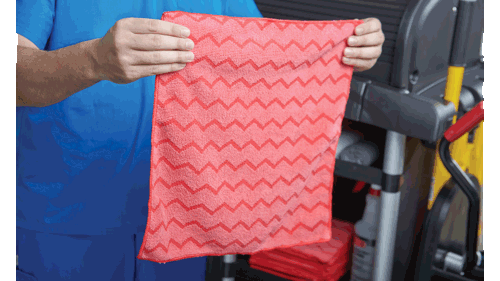
Microfibre cleaning cloths are a reliable choice for commercial cleaning. They trap dirt, dust, and bacteria better than cotton or other fabrics. Many cleaning contractors, aged care providers, and facility managers now use microfibre as part of their cleaning routine.
But if you don’t wash microfibre cloths correctly, they lose cleaning power fast. The fibres can get clogged with detergent or fabric softener, and that makes the cloth less effective on surfaces. Stains, lint, and odours can also build up if washing is done the wrong way.
Washing microfibre properly keeps the cloths in good shape. It extends their usable life and supports better hygiene across zones. Whether you’re dealing with lightly soiled cloths or cleaning ones used in high-risk areas, this guide explains how to wash microfibre cloths in commercial settings using proven steps from Rubbermaid Commercial’s HYGEN™ system.

Microfibre cloths are made of tightly woven synthetic fibres. These split fibres are much finer than human hair and are designed to lift dirt, dust, and bacteria from surfaces. That’s what makes microfibre cleaning cloths so effective for cleaning without needing strong chemicals.
The structure of the fibres gives them their cleaning power. But washing microfibre the wrong way can damage these fibres. Using hot water, high heat, or fabric softener can clog the fibres or strip away their electrostatic charge. This lowers the cloth’s ability to grab and hold dirt.
Washing with other fabrics like cotton can also reduce performance. Cotton sheds lint, which gets trapped in microfibre and makes it less effective.
Proper washing is not just about keeping cloths clean. It protects the structure of the fibre, keeps the cloth soft and absorbent, and helps you get a streak-free finish on every surface. This is why microfibre needs its own wash process.
HYGEN™ Microfibre Cloths are made for repeat washing. They are bleach safe, tested to withstand 500+ commercial laundry cycles, and are used in healthcare-grade cleaning.
Before you wash microfibre cloths in a machine, follow these steps. These simple actions help protect the fibre structure and avoid problems like lint buildup or unpleasant odour.
First, always separate microfibre cleaning cloths by colour or cleaning area. This helps with preventing cross-contamination, especially in settings like aged care or hospitality. Never mix them with cotton towels or other fabrics, as that can leave lint on the fibres.
Next, remove heavy dirt or debris from the cloth before washing. Shake it out or rinse with cold water over a flat surface. For tough stains, pretreat stains using a small amount of additive-free detergent. Avoid using harsh chemicals at this stage.
Rubbermaid’s Microfibre Charging Bucket is a good option for storing soiled microfiber towels before laundry. It keeps the cloths damp and ready for washing. You can also store dirty towels in Rubbermaid Commercial Laundry Bags to contain the mess and avoid odours.
Washing microfibre cleaning cloths the wrong way can damage their fibres and reduce their effectiveness. In commercial settings like hospitals, aged care, and hospitality, that means more work, higher replacement costs, and risk of cross-contamination. If you want to wash microfibre towels and cloths that last and perform well, you need a specific routine that protects the material and keeps dirt and bacteria from getting trapped in the fibres.
Always place microfibre towels and mop pads inside a mesh laundry bag before loading them into the washing machine. This prevents tangling, protects the fibres during the cycle, and allows you to manage inventory more efficiently. A mesh bag also reduces friction between cloths, helping you wash microfiber towels without causing wear.
Do not clean microfibre towels with cotton cloths, rags, or other fabrics. Cotton sheds lint, which clogs the fibres and reduces how well the cloth traps dust and dirt. Washing microfibre materials separately helps maintain their streak-free finish, especially when used for glass, mirrors, and polished surfaces.
Use warm water to break down grease, grime, and dirt in the fibres. Warm water is safe for most microfibre materials, helping you achieve clean results without damaging the fabric. Avoid using hot water, which can shrink the fibres or weaken their cleaning performance over time.
Stick to a liquid detergent that is fragrance-free and additive-free. Avoid powder detergent, fabric softener, or any scented product. These leave residue on the fibres and reduce their ability to lift dirt from surfaces. Additive-free detergent is the safest choice for washing microfiber towels properly.
Use a short or gentle cycle when machine washing microfibre cloths. These cloths do not need a full cycle to get clean. Long cycles can break down the fibres, especially when done frequently. A short wash paired with a good rinse removes dirt without overworking the material.
A proper rinse removes leftover detergent and dirt trapped in the cloth. If not rinsed completely, the cloth may leave streaks or cause an unpleasant odour next time it is used. Rinse in cold water or allow the machine to finish its rinse cycle without adding softeners or fragrances.
If disinfection is required, use bleach only if the cloth label confirms it is bleach safe. HYGEN™ Microfibre Cloths and Mop Pads are designed to handle chlorine bleach and repeated laundering. Always follow wash volume and dilution guidelines to avoid fibre damage or reduced performance.
Soak dirty cloths in warm water with a small amount of liquid detergent. Scrub against a flat surface to remove tough stains. Rinse thoroughly with cool water. Do not wring or twist the fabric, just press the water out gently. Line dry or place on a drying rack if not machine drying.
Pro Tip: HYGEN™ Microfibre Mop Pads are built for repeated use in commercial settings. They hold up through 500+ washes, are bleach safe, and maintain high performance even in healthcare and hospitality environments.
Once your microfibre cloths come out of the washing machine, drying them the right way is just as important as washing. Avoid high heat at all times. Microfibre materials are heat-sensitive and can shrink or melt when exposed to high temperatures. Always use a low heat setting if you are using a dryer.
Do not use dryer sheets. They coat the fibres and stop the cloth from lifting dirt properly. If possible, line dry or use a drying rack in a clean, dust-free area. This helps the cloths air dry evenly and keeps them in good shape.
Separate your loads by fabric type. Never dry microfibre with cotton or other towels that shed lint. If drying space allows, use a dedicated dryer just for microfibre.
Drying cloths the right way keeps the fibres intact, prevents lint buildup, and supports longer cloth life across regular cleaning tasks.
Clean microfibre cloths must be stored correctly to stay effective. After washing and drying, fold each towel neatly and store it on a flat surface or in a clean container. Use storage bins or enclosed carts that protect the cloth from dust, lint, or moisture. Avoid open-air shelves or shared spaces with other fabrics.
Keep microfibre towels sorted by colour or cleaning zone. This makes it easier to follow your site’s cross-contamination protocols. Colour coding also speeds up deployment, especially in healthcare, hospitality, or home cleaning setups.
Store only clean microfibre cloths. Never mix freshly washed towels with used ones. Always rotate your supply so older cloths are used first. This prevents some towels from wearing out too early while others remain untouched.
Correct storage helps keep microfibre materials in good shape. It also supports your team’s ability to start cleaning right away with ready-to-use cloths that deliver streak free results.

Washing microfibre cloths the wrong way can shorten their life and reduce cleaning performance. One of the most common mistakes is using fabric softener or dryer sheets. These leave residue that clogs fibres and lowers dirt pickup. Another issue is washing or drying microfibre towels with cotton or other fabrics that shed lint.
Avoid using too much detergent or running long, aggressive cycles. This wears out the fibres and creates buildup that causes unpleasant odour. Overloading the washing machine or using high heat during drying can also damage microfibre materials and lead to poor results on surfaces.

In healthcare, cleaning cloths must be separated by zones to avoid cross-contamination. Use colour-coded microfibre cloths for patient rooms, bathrooms, and shared areas. Store clean cloths in sealed containers and use bleach-safe options, such as HYGEN Microfibre Cloths. These are suitable for frequent laundering and disinfection in hospital environments.
Hospitality teams use microfibre towels to clean guest rooms, lobbies, and food service areas. Wash microfiber towels daily to remove dirt and prevent unpleasant odour. Avoid fabric softeners and dry using low heat. Choose cloths that stay streak-free after multiple washes to keep glass, mirrors, and benches spotless.
In schools and childcare centres, simplified colour coding helps staff stay consistent. Wash microfiber cloths used in classrooms and bathrooms separately. Use warm water and additive-free detergent. Store clean microfibre on a flat surface or a drying rack, away from other fabrics, to keep them in good condition.
To keep microfibre cloths in pristine condition, set a clear washing schedule based on use. High-traffic areas, such as healthcare or hospitality, may require daily washing, while low-traffic zones can follow a rotating cycle. Check cloths often for fraying, lint buildup, or reduced absorbency. Replace damaged towels to maintain effective cleaning.
Store only clean microfiber cloths. Keep them dry and separated from other fabrics. Use line dry or low heat if drying by machine. Avoid high heat, heavy loads, and fabric softeners. These tips help maintain the quality of your microfibre cleaning cloths for longer use.
Washing microfibre cloths the right way protects the fibres, maintains high cleaning performance, and reduces replacement costs. From separating cloths before washing to using low heat for drying, every step supports better hygiene and longer product life. Avoid common mistakes like fabric softeners, hot water, and lint-producing fabrics.
Rubbermaid Commercial’s HYGEN™ range is designed for repeated commercial washing. With bleach-safe cloths and mop pads built for high-use environments, you get reliable results every time.
Explore our Rubbermaid Commercial’s wide range of launderable microfibre cloths, mop pads, and accessories built for commercial use.